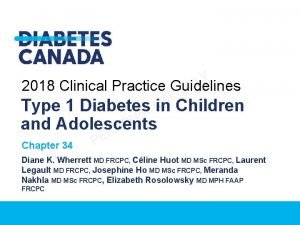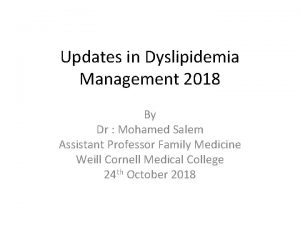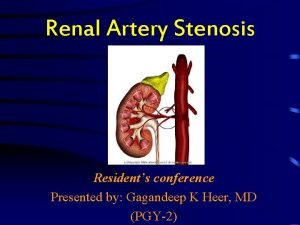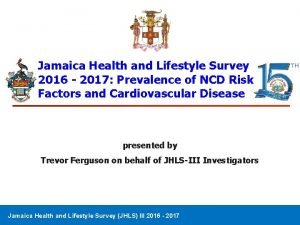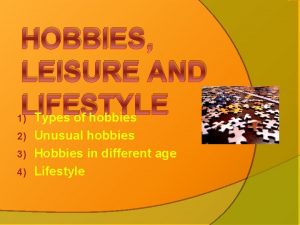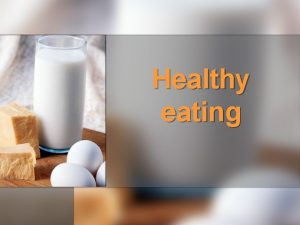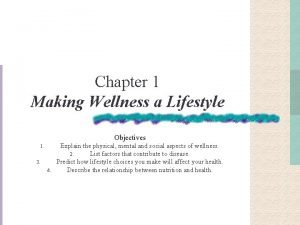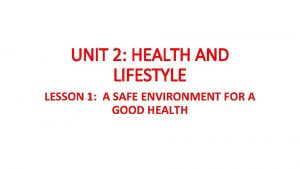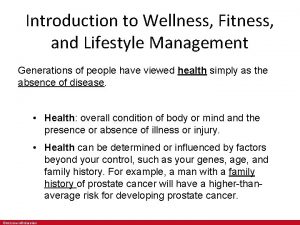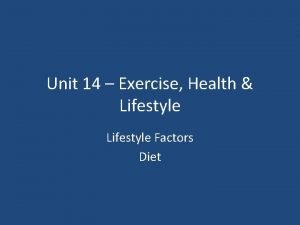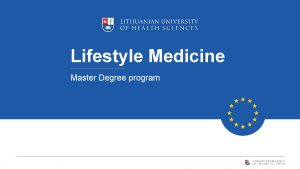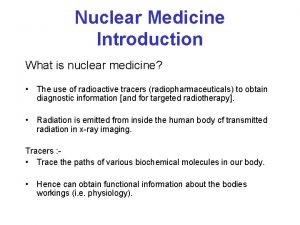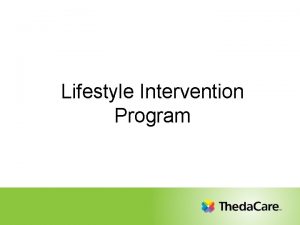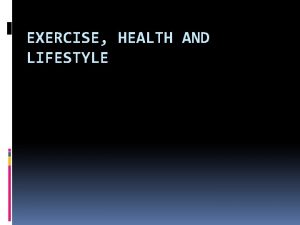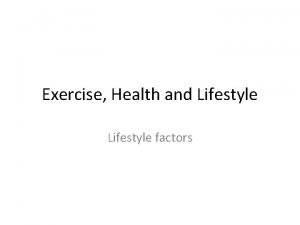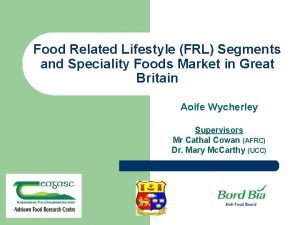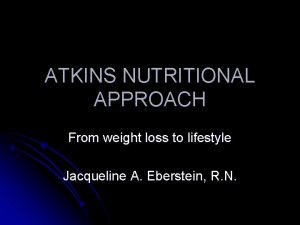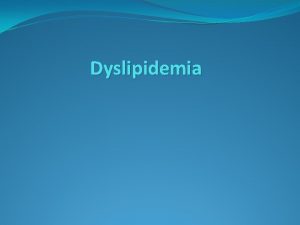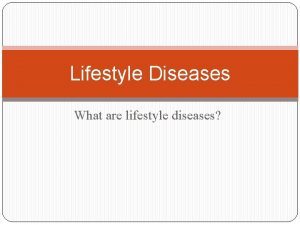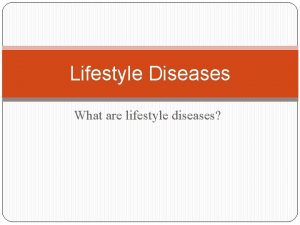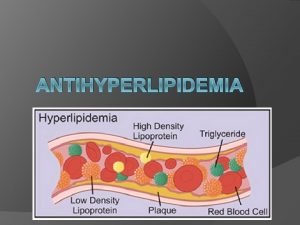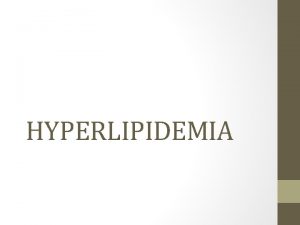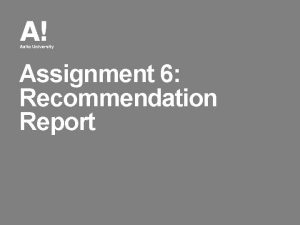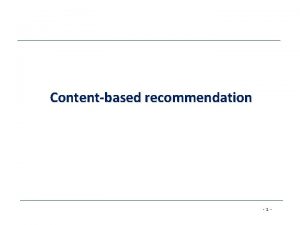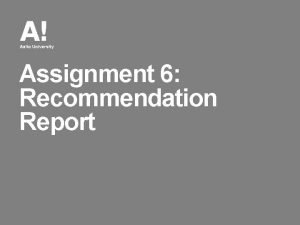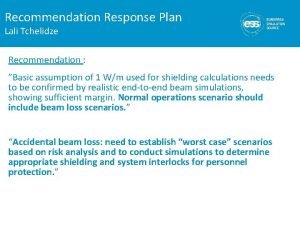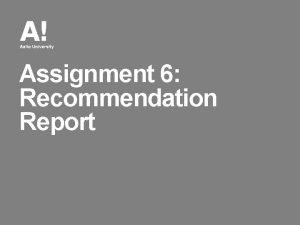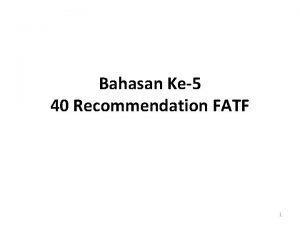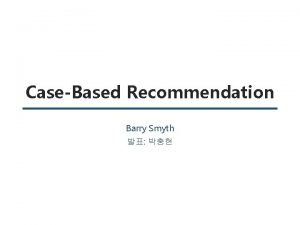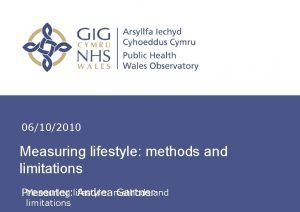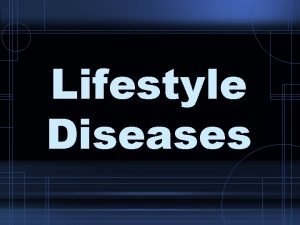1 Content Definition of dyslipidemia Lifestyle recommendation in
























































- Slides: 56

1


Content • Definition of dyslipidemia • Lifestyle recommendation in dyslipidemia • Medical Nutrition Therapy • Weight loss • Physical activity • Smoking cessation • Dietary pattern in dyslipidemia • Mediterranean diet • DASH diet • Lifestyle recommendation according to the type of dyslipidemia • Hypertriglyceridemia • Hypercholesterolemia • Low HDL-c 3

Definition of dyslipidemia v lipid lowering medications and/or v LDL-c ≥ 150 mg/d. L and/or v HDL-c <40 mg/d. L and/or v TG ≥ 150 mg/d. L Kuwabara et al. Nutrients. 2018 Aug 3; 10(8) 4

Lifestyle recommendation in dyslipidemia First-line approach (prior to lipid-lowering drugs therapy): lifestyle intervention + lipid lowering therapy: • high CVD risk such as those with FH: baseline LDL-c levels of ≥ 100 mg/dl ) • very high CVD risk (with baseline LDL-c levels of ≥ 70 mg/dl) § Jellinger PS et al. Endocr Prac 2017 Apr; 23(Suppl 2): 1 -87 § Anagnostis et al. Maturitas 2018; 108: 45– 52 5

Lifestyle recommendation in dyslipidemia (cont’d) a. Medical nutrition therapy b. Weight loss c. Physical activity d. Smoking cessation 6

Lifestyle recommendation in dyslipidemia (cont’d) a. Medical Nutrition Therapy in dyslipidemia 1. Reduced-energy intake 2. Consuming fruits and vegetables (≥ 5 servings/day) • 1 of these servings/day of dark green or orange vegetables 3. Consuming grains (primarily whole grains) 4. Consuming Legumes, unsalted nuts and seeds ≥ 4 serving/week 5. Consuming low-fat • Jellinger PS et al. Endocr Prac 2017 Apr; 23(Suppl 2): 1 • Khanji et al. Int J Cardiol. 2018 ; 263: 142 -151. dairy products 7

Lifestyle recommendation in dyslipidemia a. Medical Nutrition Therapy in dyslipidemia 6. Consuming fish, and lean (cont’d) meats, skinless poultry 7. Reduction salt intake (<2400 mg/d or <6 g/d) 8. Intake of source of probiotics 9. reduce the sugar and sugar • Jellinger PS et al. Endocr Prac 2017 Apr; 23(Suppl 2): 1 -87 • Khanji et al. Int J Cardiol. 2018 ; 263: 142 -151. sweetened beverages 8

Lifestyle recommendation in dyslipidemia a. Medical Nutrition Therapy in dyslipidemia (cont’d) 10. Soluble fiber (10 -25 g/ day) • • TC: 5 to 19% LDL-C: 8 to 24% • Foods high in soluble fiber: Oat bran, oatmeal, beans, peas, rice bran, barley, citrus fruits, strawberries, and apple Jellinger PS et al. Endocr Prac 2017 Apr; 23(Suppl 2): 1 -87 9

Lifestyle recommendation in dyslipidemia (cont’d) a. Medical Nutrition Therapy in dyslipidemia (cont’d) 11. dietary fat : 25 - 35% of calorie intake 12. PUFA: up to 10% caloric intake • Vegetable oils are higher in PUFA: safflower oils 13. MUFA: up to 20% of caloric intake • vegetable oils higher in MUFA: canola, and olive oils • Jellinger PS et al. Endocr Prac 2017 Apr; 23(Suppl 2): 1 -87 • Jacobson TA et al. J Clin Lipidol. 2015 Nov-Dec; 9(6 Suppl): S 1 -122. e 1. 10

Lifestyle recommendation in dyslipidemia a. Medical Nutrition Therapy in dyslipidemia (cont’d) Limit consumption of: 14. saturated fats (<7% of total calories) 15. cholesterol (<200 mg/day) 16. trans-fats (<1% of total calories) v each 1% of energy from TFAs raising LDL-C by 1. 5 mg/ d. L compared with carbohydrate and, to a somewhat greater extent, compared with MUFA and PUFA • Jellinger PS et al. Endocr Prac 2017 Apr; 23(Suppl 2): 1 -87 • Jacobson TA et al. J Clin Lipidol. 2015 Nov-Dec; 9(6 Suppl): S 1 -122. • Dieter et al. Trends Cardiovasc Med. 2017 Jul; 27(5): 295 -313. 11

Lifestyle recommendation in dyslipidemia (cont’d) a. Medical nutrition therapy b. Weight loss c. Physical activity d. Smoking cessation 12

Lifestyle recommendation in dyslipidemia (cont’d) b. Weight loss v ≥ 5% of body weight • LDL-C : 5 mg/dl • HDL-C: 2 -3 mg/dl Jacobson TA et al. J Clin Lipidol. 2015 Nov-Dec; 9(6 Suppl): S 1 -122. e 1. 13

Lifestyle recommendation in dyslipidemia (cont’d) a. Medical nutrition therapy b. Weight loss c. Physical activity d. Smoking cessation 14

Lifestyle recommendation in dyslipidemia (cont’d) c. Physical activity • At least 30 minutes of moderate-intensity aerobic activity, 4 to 6 times weekly • brisk walking, riding a stationary bike, water aerobics, cleaning/ scrubbing, mowing the lawn, and sporting activities • Muscle-strengthening activity is recommended at least 2 days a week Jellinger PS et al. Endocr Prac 2017 Apr; 23(Suppl 2): 1 -87 15

Lifestyle recommendation in dyslipidemia (cont’d) a. Medical nutrition therapy b. Weight loss c. Physical activity d. Smoking cessation 16

Lifestyle recommendation in dyslipidemia (cont’d) Dietary pattern recommended to dyslipidemia: • Mediterranean diet: as being low in saturated fat and high in vegetable oils, observed in Greece and Southern Italy during the 1960 s • DASH dietary pattern: a lifelong approach to healthy eating that's designed to help treat or prevent high blood pressure Khanji et al. Int J Cardiol. 2018 ; 263: 142 -151. 17

18

Mediterranean diet and dyslipidemia Feature of Mediterranean diet: • Enjoying meals • Getting plenty with family and friends of exercise Krause’s food & nutrition care process, 14 th edition; 2017, p 657 -9 19

Mediterranean diet and dyslipidemia (cont’d) Feature of Mediterranean diet (cont’d): a. Fruit and vegetables Ø An abundance and variety of plant foods should make up the majority of your meals Ø Strive for 7 to 10 servings a day of veggies and fruits Ø Greater number of servings of fruits and vegetables (mostly fresh) with an emphasis on root vegetables and greens vegetables Krause’s food & nutrition care process, 14 th edition; 2017, p 657 -9 20

Mediterranean diet and dyslipidemia (cont’d) Feature of Mediterranean diet (cont’d): b. Grains : Ø Are typically whole grain Ø Bread is an important part of the diet Ø (Usually contain very few unhealthy trans fats) Krause’s food & nutrition care process, 14 th edition; 2017, p 657 -9 21

Mediterranean diet and dyslipidemia (cont’d) Features of the diet (cont’d): c. FAT and OILS Moderate in total fat (32% to 35%) High in PUFA (especially omega-3) High levels of MUFA such as olive oil Use of canola oil, olive oil, nut oil Relatively low in saturated fat (9% to 10%) Krause’s food & nutrition care process, 14 th edition; 2017, p 657 -9 22

Mediterranean diet and dyslipidemia (cont’d) Features of the diet (cont’d): c. FAT and OILS (cont’d) Ø Olive or canola oil as a healthy replacement for butter or margarine Ø Try tahini as a dip or spread Ø The type of fats consumed is more important than total amount of fat (looking at metabolic goals and CVD risk) Ø Mediterranean-style diet: effective alternative to a diet low in total fat and high in carbohydrates Krause’s food & nutrition care process, 14 th edition; 2017, p 657 -9 23

Mediterranean diet and dyslipidemia (cont’d) Features of the diet (cont’d): d. Nuts and seed: Ø high in fat : 80% from fat Ø high in calories: should not be eaten in large amounts Ø Avoid candied or honey-roasted and salted nuts Krause’s food & nutrition care process, 14 th edition; 2017, p 657 -9 24

Mediterranean diet and dyslipidemia (cont’d) Features of the diet (cont’d): d. Beans and legumes: Ø high in soluble fiber and low GI Ø 1 serving/ day Krause’s food & nutrition care process, 14 th edition; 2017, p 657 -9 25

Mediterranean diet and dyslipidemia (cont’d) Features of the diet (cont’d): e. Herbs and spices: Ø Using herbs and spices instead of salt to flavor foods and meals Ø Herbs and spices make food tasty and are also rich in health-promoting substances. Krause’s food & nutrition care process, 14 th edition; 2017, p 657 -9 26

Mediterranean diet and dyslipidemia (cont’d) Features of the diet (cont’d): e. Fish and seafood: Ø Fatty Ø Ø fish- such as salmon omega-3 fatty acids Fish is eaten on a regular basis (once or twice a week) Rich sources of Ø Avoid fried fish Krause’s food & nutrition care process, 14 th edition; 2017, p 657 -9 27

Mediterranean diet and dyslipidemia (cont’d) Features of the diet (cont’d): f. Dairy products: Ø Limit higher fat dairy products (whole or 2 percent milk, cheese and ice cream) Ø Switch to skim milk, fat-free yogurt and low-fat cheese Krause’s food & nutrition care process, 14 th edition; 2017, p 657 -9 28

Mediterranean diet and dyslipidemia (cont’d) Features of the diet (cont’d): g. MEAT: Ø Substitute fish and poultry for red meat Ø When eaten, make sure it's lean and keep portions small Ø Also avoid sausage, and other high-fat meats Krause’s food & nutrition care process, 14 th edition; 2017, p 657 -9 29

Lifestyle recommendation in dyslipidemia (cont’d) Dietary pattern recommended to dyslipidemia: • Mediterranean diet: as being low in saturated fat and high in vegetable oils, observed in Greece and Southern Italy during the 1960 s • DASH dietary pattern: a lifelong approach to healthy eating that's designed to help treat or prevent high blood pressure Khanji et al. Int J Cardiol. 2018 ; 263: 142 -151. 30


Lifestyle recommendation according to the type of dyslipidemia 32

Lifestyle recommendations according to the type of dyslipidemia a. Hypertriglyceridaemia: • Borderlines TG (150 -199 mg/dl) • High TG (200 -499 mg/dl) • Very high TG (>500 mg/dl) b. Hypercholesterolaemia • TC >200 mg/dl • LDL-c >150 mg/dl c. Low HDL-c • In men: HDL-c < 40 mg/dl • In women: HDL-c <50 mg/dl 33

Lifestyle recommendation in hypertriglyceridemia 1. 2. 3. 4. 5. 6. 7. loss of weight loss Dietary carbohydrate Dietary fat Dietary protein Increase physical activity Reduction of alcohol consumption Mediterranean diet 34

Lifestyle recommendations for hypertriglyceridemia 1. Loss of excessive body weight (5– 10%) v Borderline TG (150– 199 mg/dl): weight loss of up to 5% 3 -kg loss of body weight: ∼ 15 mg/dl in TG v High TG (200– 499 mg/dl) or very high TG (>500 mg/d): weight loss of 5– 10% • Jellinger PS et al. Endocr Prac 2017 Apr; 23(Suppl 2): 1 -87 • Jacobson TA et al. J Clin Lipidol. 2015; 9(6 Suppl): S 1 -122. e 1. • Anagnostis et al. Maturitas 2018; 108: 45– 52 20% in TG 35

Lifestyle recommendations for hypertriglyceridemia (cont’d) 2. Dietary carbohydrate • Limit carbohydrates in diet (<60% of total energy) Recommended rang (45 -55 %) Limit Refined starches and simple carbohydrates Carbohydrates from less refined sources, such as brown rice and whole-grain bread, can also raise the TG concentration added sugars: up to 5– 10% • Jellinger PS et al. Endocr Prac 2017 Apr; 23(Suppl 2): 1 -87 • Jacobson TA et al. J Clin Lipidol. 2015; 9(6 Suppl): S 1 -122. e 1. • Anagnostis et al. Maturitas 2018; 108: 45– 52 36

Lifestyle recommendations for hypertriglyceridemia (cont’d) 2. Dietary carbohydrate (cont’d) Low GI diets + 45– 50% of energy intake from carbohydrate efficacious on lowering Tg compared with conventional diets (55– 60% of energy from carbohydrates and energy restriction to 250– 500 kcal/d) • Jellinger PS et al. Endocr Prac 2017 Apr; 23(Suppl 2): 1 -87 • Jacobson TA et al. J Clin Lipidol. 2015; 9(6 Suppl): S 1 -122. e 1. • Anagnostis et al. Maturitas 2018; 108: 45– 52 37

Lifestyle recommendations for hypertriglyceridemia (cont’d) 2. Dietary carbohydrate in high and very high TG v High TG (200 -499 mg/dl) • Dietary carbohydrate: 50 -55 % of daily energy intake v Very High TG (>500 mg/dl) • Dietary carbohydrate: • Jellinger PS et al. Endocr Prac 2017 Apr; 23(Suppl 2): 1 -87 • Jacobson TA et al. J Clin Lipidol. 2015; 9(6 Suppl): S 1 -122. e 1. • Anagnostis et al. Maturitas 2018; 108: 45– 52 45 -50 % of daily energy intake 38

Lifestyle recommendations for hypertriglyceridemia 3. Dietary (cont’d) fat for: v Borderline TG (150 -199 mg/dl) • Total fat: 25 -35 % of daily energy intake • SFA < 7% • MUFA and PUFA : 10– 20% of daily energy intake v High and very high TG (>200 mg/dl) • Total fat : 30– 35% of daily energy intake • SFA < 5% • MUFA and PUFA : 10– 20% of daily energy intake • Jellinger PS et al. Endocr Prac 2017 Apr; 23(Suppl 2): 1 -87 • Jacobson TA et al. J Clin Lipidol. 2015; 9(6 Suppl): S 1 -122. e 1. • Anagnostis et al. Maturitas 2018; 108: 45– 52 39

Lifestyle recommendations for hypertriglyceridemia (cont’d) 3. Dietary fat (cont’d) consuming the omega-3 fatty acids (3 -4 g/d): • 2 servings (120 g) of fatty fish per week: • TG by 25% or more (depending on baseline concentration) • slight in LDL-C levels • HDL-C levels • Unsalted nuts (1 serving/day) • Jellinger PS et al. Endocr Prac 2017 Apr; 23(Suppl 2): 1 -87 • Jacobson TA et al. J Clin Lipidol. 2015; 9(6 Suppl): S 1 -122. e 1. • Anagnostis et al. Maturitas 2018; 108: 45– 52 40

Lifestyle recommendations for hypertriglyceridemia (cont’d) 4. Dietary protein: v High TG (200 -499 mg/dl) 15 -20 % of daily energy intake v Very high TG (>500 mg/dl) 20 % of daily energy intake • Jellinger PS et al. Endocr Prac 2017 Apr; 23(Suppl 2): 1 -87 • Jacobson TA et al. J Clin Lipidol. 2015; 9(6 Suppl): S 1 -122. e 1. • Anagnostis et al. Maturitas 2018; 108: 45– 52 41

Lifestyle recommendations for hypertriglyceridemia (cont’d) 5. Dietary fructose (sugar sweetener beverages, cookies and cakes) v Borderline TG (200 -499 mg/dl) • <100 g/d v High TG (200– 499 mg/dl) • 50 -100 g/d v Very high TG (>500 mg/dl) • <50 g/d Fructose in each serving of Fruits: 6 -18 g • Jellinger PS et al. Endocr Prac 2017 Apr; 23(Suppl 2): 1 -87 • Jacobson TA et al. J Clin Lipidol. 2015; 9(6 Suppl): S 1 -122. e 1. • Anagnostis et al. Maturitas 2018; 108: 45– 52 42

Lifestyle recommendations for hypertriglyceridemia 6. increased physical (cont’d) activity (at least 30 min, ≥ 5 days/week) 7. Reduction of alcohol consumption 8. Mediterranean style diet • Jellinger PS et al. Endocr Prac 2017 Apr; 23(Suppl 2): 1 -87 • Jacobson TA et al. J Clin Lipidol. 2015; 9(6 Suppl): S 1 -122. e 1. • Anagnostis et al. Maturitas 2018; 108: 45– 52 43

Lifestyle recommendations according to the type of dyslipidemia a. Hypertriglyceridaemia: • Borderlines TG (150 -199 mg/dl) • High TG (200 -499 mg/dl) • Very high TG (>500 mg/dl) b. Hypercholesterolaemia • TC >200 mg/dl • LDL-c >150 mg/dl c. Low HDL-c • In men: HDL-c < 40 mg/dl • In women: HDL-c <50 mg/dl 44

Lifestyle recommendation in hypercholesterolemia 1. 2. 3. 4. 5. Low SFA and TFAs Weight loss Dietary fiber Physical activity Dietary pattern: • NCEP Step I Therapeutic lifestyle change diet • NCEP Step II Therapeutic lifestyle change diet • NCEP: National Cholesterol Education Program 45

Lifestyle recommendations for hypercholesterolemia (cont’d) 1. SFA (< 10%) & TFAs (< 1%) 2. Weight loss (5– 10%) 10 kg weight loss: 8. 9 mg/dl LDL-c 3. Increase of dietary fiber (14 g/1000 kcal) 4. Increase of physical • Jellinger PS et al. Endocr Prac 2017 Apr; 23(Suppl 2): 1 -87 • Anagnostis et al. Maturitas 2018; 108: 45– 52 activity (at least 30 min, ≥ 5 days/week) 46

Dietary pattern for hypercholesterolemia (cont’d) v NCEP Step I therapeutic lifestyle change diet v NCEP Step II therapeutic lifestyle change diet • NCEP: National Cholesterol Education Program • Jellinger PS et al. Endocr Prac 2017 Apr; 23(Suppl 2): 1 -87 • Anagnostis et al. Maturitas 2018; 108: 45– 52 47

Dietary pattern for hypercholesterolemia (cont’d) NCEP Step I Therapeutic life style change diet: Ø Ø Ø Ø Saturated fat: < 10% PUFA: Up to 10% MUFA: Up to 20% Carbohydrate: 50% to 60% Soluble fiber: At least 5 to 10 grams a day Protein: 15% of total calories Cholesterol: <300 mg a day Total calories: Balance calories and stay at a healthy weight • Jellinger PS et al. Endocr Prac 2017 Apr; 23(Suppl 2): 1 -87 • Anagnostis et al. Maturitas 2018; 108: 45– 52 48

Dietary pattern for hypercholesterolemia (cont’d) NCEP Step II Therapeutic life style change diet: Saturated fat: < 7% Ø PUFA: Up to 10% Ø MUFA: Up to 20% Ø Carbohydrate: 50% to 60% Ø Soluble fiber: At least 5 to 10 grams a day Ø Protein: 15% of total calories Ø Cholesterol: <200 mg a day Ø Total calories: Balance calories and stay at a healthy weight. Ø • Jellinger PS et al. Endocr Prac 2017 Apr; 23(Suppl 2): 1 -87 • Anagnostis et al. Maturitas 2018; 108: 45– 52 49

Dietary pattern for hypercholesterolemia (cont’d) NCEP Step II therapeutic life style change recommendation (2) Food group: Number of servings Serving size • Lean meat, poultry, fish < 5 ounces a day • 5 ounces maximum a day of lean meat, poultry, or fish • Substitute ¼ cup dry beans or peas for 1 ounce of meat. • Eggs < 2 yolks a week • 1 whole egg. Egg whites or substitutes are not limited. • Low-fat milk and milk products 2– 3 a day • 1 cup fat-free or 1% milk • 1 cup nonfat or low-fat yogurt • 1 ounce nonfat or low-fat cheese (3 grams of fat or less per ounce) • Fruits 2– 4 a day • Jellinger PS et al. Endocr Prac 2017 Apr; 23(Suppl 2): 1 -87 • Anagnostis et al. Maturitas 2018; 108: 45– 52 • 1 piece fruit, such as apple, orange, or ½ a banana • ½ cup canned fruit • 1 cup berries or melon • ¾ cup fruit juice 50

Dietary pattern for hypercholesterolemia (cont’d) NCEP Step II therapeutic life style change recommendation Food group: • Vegetables • Bread, cereals, pasta, rice, and other grains • Sweets and snacks • Jellinger PS et al. Endocr Prac 2017 Apr; 23(Suppl 2): 1 -87 • Anagnostis et al. Maturitas 2018; 108: 45– 52 Number of servings 3– 5 a day Serving size • 1 cup raw leafy greens • ½ cup cooked or raw vegetables • ¾ cup vegetable juice At least 6 a day • 1 slice of bread • ½ hot dog or hamburger bun, bagel, or English muffin • 1 ounce cold cereal • ½ cup cooked pasta, rice, noodles, or other grains Within calorie limit • Choose snacks that are low in fat or are made with unsaturated fat. 51

Dietary pattern for hypercholesterolemia (cont’d) NCEP Step II therapeutic lifestyle change recommendation Duration of Nutrition Therapy: • In primary prevention: at least 3 -6 months before initiating lipid-lowering drug therapy • Re-assess individuals’ lipid status for every 6 week intervals until the treatment goals is achieved Jellinger PS et al. Endocr Prac 2017 Apr; 23(Suppl 2): 1 -87 52

Lifestyle recommendations according to the type of dyslipidemia a. Hypertriglyceridaemia: • Borderlines TG (150 -199 mg/dl) • High TG (200 -499 mg/dl) • Very high TG (>500 mg/dl) b. Hypercholesterolaemia • TC >200 mg/dl • LDL-c >150 mg/dl c. Low HDL-c • In men: HDL-c < 40 mg/dl • In women: HDL-c <50 mg/dl 53

Lifestyle recommendations for low HDL-C (cont’d) 1. Increase of physical activity (at least 30 min, ≥ 5 days/week) 2. Reduction of TFAs (< 1%) 3. Weigh loss (5– 10%) • A 5– 8 kg weight loss may increase HDL-c by 2– 3 mg/dl • weight loss of 5– 10% is adequate to cause an 8% to 10% increase in HDL-c 4. Reduction of dietary carbohydrate intake and their substitution with MUFA and PUFA Anagnostis et al. Maturitas 2018; 108: 45– 52 54

Lifestyle recommendations for low HDL-C (cont’d) 5. Smoking cessation 6. Reduction of simple sugar 7. Consumption of low glycemic index carbohydrates (high fiber, whole grain foods) Anagnostis et al. Maturitas 2018; 108: 45– 52 55

 Dyslipidemia cpg
Dyslipidemia cpg Dyslipidemia
Dyslipidemia Hypertensive emergency definition
Hypertensive emergency definition Deep content-based music recommendation
Deep content-based music recommendation Real content and carrier content in esp
Real content and carrier content in esp Dynamic content vs static content
Dynamic content vs static content Active lifestyle definition
Active lifestyle definition Lecture on healthy lifestyle
Lecture on healthy lifestyle Packet countable or uncountable
Packet countable or uncountable Lifestyle modern
Lifestyle modern Jamaica health and lifestyle survey
Jamaica health and lifestyle survey Lifestyle and hobbies
Lifestyle and hobbies We will be healthy complete the sentence
We will be healthy complete the sentence Bahagi ng editoryal
Bahagi ng editoryal What is fashion logistics
What is fashion logistics Miss chris spanks
Miss chris spanks Valstm
Valstm Making wellness a lifestyle
Making wellness a lifestyle Why do geographers call arabia a crossroads location
Why do geographers call arabia a crossroads location Lmseg
Lmseg Lifestyle dimensions
Lifestyle dimensions Planning gaa
Planning gaa 7th day adventist lifestyle
7th day adventist lifestyle Contoh gaya hidup modern dalam keluarga adalah
Contoh gaya hidup modern dalam keluarga adalah Healthy mood board
Healthy mood board Unit 2 lifestyle
Unit 2 lifestyle Unhealthy lifestyle of today's youth
Unhealthy lifestyle of today's youth Sparta lifestyle
Sparta lifestyle Planning gaa
Planning gaa Gaa lifestyle
Gaa lifestyle Lifestyle reporting
Lifestyle reporting Life acrostics
Life acrostics Introduction to wellness fitness and lifestyle management
Introduction to wellness fitness and lifestyle management Wellness and lifestyle management
Wellness and lifestyle management Lifestyle performance profile
Lifestyle performance profile Marita leachon
Marita leachon Drive.google
Drive.google Factors affecting oxygenation ppt
Factors affecting oxygenation ppt Athen vs sparta
Athen vs sparta Exercise health and lifestyle
Exercise health and lifestyle Positive effects of the industrial revolution
Positive effects of the industrial revolution Masters in lifestyle medicine
Masters in lifestyle medicine Now lifestyle autoresponder
Now lifestyle autoresponder Lifestyle
Lifestyle Types of nuclear medicine
Types of nuclear medicine Lifestyle entrepreneur characteristics
Lifestyle entrepreneur characteristics 101 lolitas
101 lolitas Thedacare lifestyle intervention program
Thedacare lifestyle intervention program Fitness is a lifestyle
Fitness is a lifestyle Exercise health and lifestyle
Exercise health and lifestyle Exercise health and lifestyle
Exercise health and lifestyle For adult
For adult Endocrinologist lifestyle
Endocrinologist lifestyle Leisure time and hobbies
Leisure time and hobbies Food related lifestyle model
Food related lifestyle model Firstbeat lifestyle assessment
Firstbeat lifestyle assessment Atkins lifestyle
Atkins lifestyle
